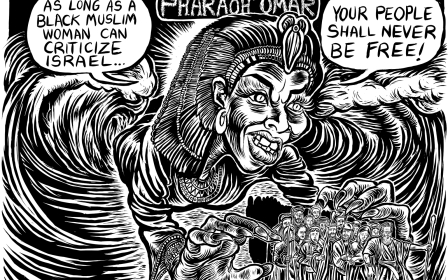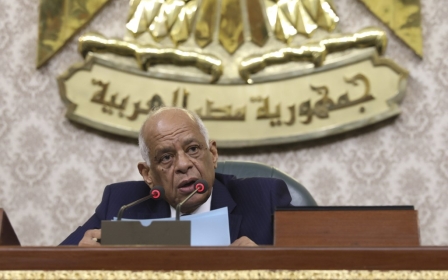Egypt protests: How cartoon of Sisi the cat burglar became face of a movement

Ganzeer says the idea had long been brewing in his head.
He had watched from his adopted home in Houston, Texas as allegations of corruption levelled against Egyptian President Abdel Fattah el-Sisi by former military contractor Mohamed Ali began fomenting public anger against the government.
The discussions online told him that the corruption saga would trigger a population facing mounting economic challenges and endless repression. A storm was coming.
"I just wanted to pitch in, but I wasn't sure how," says the 37-year-old street artist, who made his name in Cairo during the 2011 revolution against Hosni Mubarak.
New MEE newsletter: Jerusalem Dispatch
Sign up to get the latest insights and analysis on Israel-Palestine, alongside Turkey Unpacked and other MEE newsletters
"If I were in Cairo now, I would have taken to the streets with graffiti, like I did in 2011. I kept on wondering: how can I participate in a concrete and positive way, and make it useful?"
On the morning of 20 September, Ganzeer woke up anxious. During the next few hours he drew the image that has quickly come to define a new wave of protests against the sitting president. In the illustration, Sisi is dressed in a striped jacket and tie, but drawn as a cartoonish cat burglar.
'I kept on wondering: How can I participate in a concrete and positive way, and make it useful?'
- Ganzeer, artist
Ganzeer initially released the image in private groups as well as on his Instagram page. The image quickly went viral. Above the image the slogan reads in English: "Arrest Sisi. Free Egypt," and below in Arabic: "Down with the betrayers, regime remnants, [Muslim] Brotherhood".
Activists and protesters have added their own slogans to the cartoon, as well as printing it out, cutting it up, and turning it into masks, banners and posters.
It has popped up at protests in New York, Washington, Berlin, Paris and Oslo, and even in the back alleys of Cairo.
"There is no way it can end up in Tahrir Square," Ganzeer says wryly. "Not with the security crackdown there."
Rising anger
Egypt has seen an outbreak of protests against Sisi since 20 September, when protesters took to the streets of Cairo and other cities, calling for him to step down.
The demonstrations, and the online campaigns that have fuelled them, have been the most public show of opposition to the president since a crackdown on dissent after the 2013 military coup that brought Sisi to power. Hundreds of protesters were killed by security forces in Rabaa Square, with tens of thousands more arrested and imprisoned.
A new wave of repression has followed this month's protests, with more than 2,200 people arrested, according to local activists. Last Friday Egyptian security forces locked down the centre of Cairo and other cities to deter crowds from taking to the streets.
But the slump in the economy, which has seen the number of people living below the poverty line rise between 2015 and 2018, has left many Egyptians seething with anger.
Activists say Ganzeer's image not only plugged into the rising anger on the streets; drawing Sisi as a burglar fundamentally stripped the president down from a so-called statesman to an ordinary, petty thug who had literally stolen the presidency and now the coffers of the state.
"The image has resonated with many Egyptian because it outlines the economic suffering currently playing out in the country," Ahmed el-Hahdy, an Egyptian activist living in Princeton, New Jersey, tells MEE.
"Given Sisi's corruption and theft of national wealth, he has become an integral part of people's everyday suffering."
Activists supporting the anti-Sisi campaign say they have faced coordinated opposition online, with several saying that their social media accounts have been reported and, in some instances, blocked or suspended.
Ganzeer's Twitter account was among those briefly suspended earlier this week. After appealing, he says Twitter told him that he had been suspended for "using a trending hashtag or popular hashtag with an intent to subvert or manipulate a conversation or to drive traffic or attention to accounts, websites, products or initiatives" and for "tweeting with excessive, unrelated hashtags in a single tweet or across multiplate tweets".
Middle East Eye asked Twitter why it had suspended the accounts of Egyptian activists and whether it was investigating the closures.
'Social issues inform my work. It comes first. And there will be more actions to come'
- Ganzeer
A spokesperson, responding by email, said that the site takes action when behaviour violates its platform manipulation and spam policy.
"Additionally, Twitter regularly discloses data in relation to state-backed information operations on the service in what is now the largest archive of its kind in the industry," the spokesperson said.
Blocking trolls
Ganzeer says his Twitter account was reactivated a couple of hours after he filed his appeal, but he told MEE he believed he had faced a coordinated online attack since publishing the image of Sisi.
"Since I released the image, I have had to spend a lot of time just blocking [trolls]. It has been coordinated with a number of suspicious handles and accounts that clearly began in September."
Dalia Wassef, another activist, and one of the main organisers of a series of anti-Sisi protests in New York City, where Ganzeer's image is featured prominently, described the illustration as "portraying reality and confrontational".
"It shows the anger of the Egyptian public over the corruption of the army and the generals," Wassef told MEE.
But Ganzeer is quick to clarify that though Sisi has been depicted as a cartoonish cat burglar, it shouldn't be seen as an attempt to understate the level of oppression that has characterised the president's rule.
"Some back home are complaining that people are ignoring the deaths and detentions and crackdowns and his attempt to stay in power and are now talking about corruption.
"But if you ask me, I think this wave of protest is about exposing Sisi as a liar from the inside - and you could say it's a key to opening up all the other lies."
Ganzeer has repeatedly satirised Sisi's brutal rule in comic books, graffiti and art installations. He is no stranger to attacks by Sisi's supporters or the state, which have forced him to stay in the US since 2014 amid fears for his safety.
In 2014, he worked with Captain Borderline, an art collective, and the artist Sampsa in launching a social media and street art campaign called #SisiWarCrimes.
In 2018, he worked on a comic for The Nib, which detailed life in Cairo under Sisi.
In his attempt to make it clear his work and protest had nothing to do with the Muslim Brotherhood, a group that has been vilified by the Egyptian state, he says he has been chastised by them, too.
"The activism of Ganzeer gives a prime example of how creative artists can contribute to revolutionary change and unite political messaging in ways that go beyond the usual party centred political ideological messaging," says el-Hahdy.
Ganzeer says he won't be stopping any time soon.
"Social issues inform my work. It comes first," Ganzeer says. "And there will be more actions to come."
This article is available in French on Middle East Eye French edition.
Middle East Eye delivers independent and unrivalled coverage and analysis of the Middle East, North Africa and beyond. To learn more about republishing this content and the associated fees, please fill out this form. More about MEE can be found here.


![[Facebook]](/sites/default/files/styles/article_page/public/screen_shot_2019-10-02_at_11.47.05_pm.png?itok=3uZVionZ)
![Activists compiled names of all 2,200 detainees on a banner and demand for their release [MEE/Azad Essa]](/sites/default/files/styles/article_page/public/sisiprotest_0.jpg?itok=MfXY6B0v)
![Ganzeer's original image with the words "Down with the betrayers: the military, [regime] remnants, [Muslim] Brotherhood" in Arabic below (Ganzeer) Ganzeer's original image with the words "Down with the betrayers: the military, [regime] remnants, [Muslim] Brotherhood" in Arabic below (Ganzeer)](/sites/default/files/sisi-face2_arrest.jpg)


